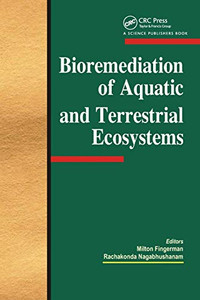

Sale
Aquatic Contamination: Tolerance and Bioremediation
Wiley
ISBN13:
9781119989288
$185.00
$179.85
More than two-thirds of the earth is covered with aquatic habitats that play a key role in stabilizing the global environment and providing a wide variety of services to increasing human needs. Nevertheless, anthropogenic activities are rapidly destroying the quality of both fresh and marine waters over the globe due to excessive use of chemicals and fertilizers, and pollution from suburban and industrial areas eventually make their way into the aquatic world. To preserve the integrity of aquatic environs is the greatest challenge in the current era because more than 80 per cent of urban wastewater, millions of tons of heavy metals chemical, toxic sludge and other waste are being directly discharged into inland waters. There are many reports that bacteria and plant species are using biodegradation and bioremediation strategies. The potential drivers of the commercial use of biological resources are yet to be explored as there are issues involved with technological facilitation and it's need for large investment funds, so there is a need to explore better training and development of more eco-friendly biological resources. After global investigation, the use of biological remediation technologies to deal with environmental problems should become standard practice, even though respondents are striving to apply bioremediation techniques. As microorganisms have evolved different survival strategies in heavier metal-polluted conditions such as biosorption, bioaccumulation or biomineralisation, which are either ex situ or in situ exploitation, these organisms are known to evolve and introduce specific detoxification mechanisms. The use of microbes as a time-saver for bioremediation was a result of the complexities involved in conventional soil regeneration methods. There are so many fungal species (like genera Penicillium, Aspergillus and Rhizopus) which has been identified as potential microbial agents for the removal of heavy metals from aqueous solutions but due to toxicity of chemical or heavy metals, it is difficult to maintain a healthy population of microorganisms hence high throughput genetic engineering tools and techniques need to be employed to attain resistant strains to degrade xenobiotic compounds. A novel technology for obtaining highly efficient biosorbents from endophytes, a hyperaccumulator, which is more convenient than the traditional method of obtaining biosorbents. Genomics, for instance in GMO plants, have been studied and used primarily in microbial genetics, but it is now a new instrument for bioremediation. Knowledge of genomics in the sense of understanding microbiological remediation provides a view of genes linked to microbial exposure to soil toxic metals. The use of genomics in bioremediation enables microorganisms to be analyzed on the basis both of biochemical and mechanism-related molecular levels.--
- | Author: Rouf Ahmad Bhat, Gowhar H. Dar, Fernanda M. Tonelli, Saima Hamid
- | Publisher: Wiley
- | Publication Date: Dec 18, 2023
- | Number of Pages: 416 pages
- | Language: English
- | Binding: Hardcover
- | ISBN-10: 1119989280
- | ISBN-13: 9781119989288
- Author:
- Rouf Ahmad Bhat, Gowhar H. Dar, Fernanda M. Tonelli, Saima Hamid
- Publisher:
- Wiley
- Publication Date:
- Dec 18, 2023
- Number of pages:
- 416 pages
- Language:
- English
- Binding:
- Hardcover
- ISBN-10:
- 1119989280
- ISBN-13:
- 9781119989288





